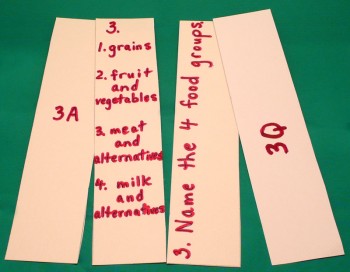Lesson Plans for Elementary School Students
Full Length Lesson Plans from an Elementary School Teacher
Health and Nutrition Lesson Plan: Spill Your Guts (Review Game)

This is a review game for any subject. Using leftover pieces of bristol board or heavier paper scraps (free from printing shops), question and answer cards are made. Teacher can do this in every subject as it’s being taught (or assign each question and answer to a student), to be used as a review tool later in this team game. This works really well for topics that have a definite number of answers.
Example:
Question:
Name the 4 food groups.
Answer:
- Grain Products
- Vegetables and Fruit
- Meat and Alternatives
- Milk and Alternatives (other sample Q and A at the end of this lesson)
Objectives:
- To review facts and information already learned.
- To have fun, working as a team.
- Turn taking.
Materials:
- bristol board scraps or thicker paper, big enough to print a question or an answer (I use print shop scraps that are about 2 inches by 8 1/2 inches. You can use card-size pieces as well. Shape doesn’t really matter.)
- thin marker to print question on one side and 1Q or 2Q or 3Q on the back side (for 3rd question). The answers are numbered on one side, for example: “1. Asia, Australia, Africa, North America, South America, Europe, and Antarctica.” (if it’s the 5th question, it would be “5Q” on one side, and on the other “5. How many continents are in the world? Name them. )
- scrap paper for recording times
- two pencils, one for each team
Method:
- As you’re learning facts, print up questions and answers on the pieces of bristol board. Students can be assigned to print up a question and answer as it is learned. (in older grades)
- After a topic has been studied, and the cards are made up, split the class into two teams.
- Team one is asked a question and they “Spill Their Guts”, shouting out all the answers they can think of as quickly as possible.
- Team two gets the answer card listing the answers. They are responsible for listening to hear all the answers given, they time how long it takes to answer the question, and they let Team one know if they’ve said all the answers. (They record the times. They need to be totalled at the end.)
- Next, Team two is asked the question and Team one listens, times the response, and tells them if they said all the answers.
- The winning team is the one who answers in the least amount of time.
- There can be “coaching time” if needed.
- You can count points if you want, one point for each answer, but not necessary.
- If you can’t understand all the answers being shouted out, you can go down the line, with one person giving one answer or passing.
- If students do a lot of yelling, you can say no yelling or you’ll be penalized one point.
Example questions and answers:
- Q: What group does ‘rice’ belong to?
A: Grain Products - Q: Name 3 things you could eat from ‘Vegetables and Fruit’ group?
A:- fresh, frozen, canned vegetables
- leafy vegetables
- fresh, frozen, canned fruit
- juice
- examples of any group like peas, bananas, orange, pepper, squash
- Q: What group does ‘cheese’ belong to?
A: Milk and Alternatives - Q: Name 3 things you could eat from ‘Grain Products’ group?
A:- bread
- bagel
- flat breads
- Naan
- rice
- bulgur
- quinoa (keen-wah)
- hot or cold cereal
- pasta
- spaghetti
- couscous (coos coos)
- Q: If you’re really thirsty, what should you drink?
A: water (calorie-free and hydrating) - Q: Should you eat oils and fats?
A: Yes, in moderation, small amounts are best. - Q: Do children, teens, and adults need the same number of servings?
A: No, different amounts for each.
Tags: any subject, flash cards, food groups, review game, teams, turn taking
